With increasing frequency, we find ourselves eating in the midst of artwork created by either LA transplant Robert Tatum or SA native Gilbert Duran—two distinct characters who don’t quite fit within the confines of the local gallery scene. While Tatum’s work—which incorporates logo design, outdoor signage and murals—can be seen at Sip, Il Sogno, Umai Mi, The Luxury, Augie’s Barbed Wire Smokehouse Bar-B-Que, Mellow Mushroom, Tuk Tuk Tap Room and beyond (not to mention nearly every local bar named after a big city), Duran’s paintings and giclée prints factor prominently into the interiors of Rosario’s and SoLuna but also hang at Bohanan’s, Bistro Vatel, Bite, Zinc, Taco Haven ... and the list goes on.
[Gallery: the Artwork of Gilbert Duran and Robert Tatum]
Unsurprisingly, both artists had their first San Antonio shows in (now bygone) restaurants. They also happen to be neighbors and have known each other since the early 1990s. Their styles, however, are vastly different: Tatum’s irreverent, street-smart aesthetic, comic use of animals and advertising chops make his pieces fairly easy to pick out. But Duran’s tendency to reinterpret and even localize works by a number of famous artists (including but not limited to Fernando Botero, Frida Kahlo, Andy Warhol and Pierre-Auguste Renoir) can make his paintings trickier to identify.
We sat down with the California dude turned Southtown rebel and the self-described “artist non-grata,” asked them similar questions and got wildly diverse answers dealing with everything from deviled eggs and mural maintenance to margaritas and the Moulin Rouge.
GILBERT DURAN
How would you introduce yourself to Current readers that may have seen your work out and about in San Antonio?
I have been painting for a very long time here in the city. I did take a hiatus to El Paso for 10 years and returned back September 11, 2001, when I opened up my studio, where Studio 911, Rosario’s and Fisher Heck Architects are in the same building. And the Rosario’s restaurant is like a gallery to me, and also a kitchen to me. ... A lot of my art is in restaurants; a lot of restaurants request my work, but it takes an enormous expense in time, you know, to say yes to my friends that own restaurants. And they do buy my work and display [it] ... and I do have favorite places ... like Rosario’s, SoLuna, Bohanans, Boudro’s, Zinc ...
Can you describe what the theme or style is and how it’s different in each of those places?
I can paint in many different directions: abstract, modern art, wildlife, landscape ... and I sculpt, do mosaics—everything. ... I enjoy it and it’s a challenge. I do read the biography of all the artists that I’m trying to interpret. ... There’s Botero, Picasso, Gauguin or Porfirio Salinas; that’s what I do.
Could you pinpoint a signature piece and give us the story behind it?
Well I do like the Frida Margarita. You know that painting is really popular. When Diego Rivera’s daughter was here in San Antonio years back for a book signing at La Mansion del Rio, she was presented one of the prints of Frida Margarita ... Frida Kahlo was her stepmother at one time.
What can you tell us about the legacy of the Stone Oak Fork?
Well, I was commissioned to do it by Damien [Watel] from Bistro Vatel. And so we did it; we accomplished it. It took a long time to do it, because it was my first public art. It was just heartbreaking to put a wall around it, for a piece of public art, it felt like it was a little Berlin Wall going up around it. It really was not a sign like they said it was. A sign would be by the curb ... this was between two courtyards, two buildings. ... But the fork suffered and my publicity was cut in half.
In terms of venues where you have your work, have you sought any out or do they find you?
No; it just happens by chance ... I’ll be getting information that there’s a place that’s going to open up ... and it turns out to be one of my friends and, “Hey, if you need anything let me know” and “Oh yeah, we do.” But they do come look for me.
Did you make a conscious decision to move away from galleries to show in non-galleries?
At the time I had a home studio in Whispering Oaks ... I didn’t really need to be in galleries because I also did weekend shows all over the state—the Laguna Gloria show in Austin, the River Show here, the Art League show here, the Rodeo and the Kiwanis Club ... I used to sell out.
Do you remember what your first show was in San Antonio?
One of my very first exhibitions of my art was at Christie’s restaurant on Broadway, the fish place. I was painting at the time and I think I had just done one or two starving artists’ shows.
How did that happen, the Christie’s show?
They had other paintings on exhibit and had prices on them. So I just asked them if they had room for any more art, and they said they did. I took them one and they called me the next day and it sold. And I took them another one and it sold. I mean it was like maybe like $40, $60, which was pretty good money back then.
And when was that do you think?
I would say the early ’70s.
Wow.
But I remember the first person that bought one was an executive at Frost Bank.
I guess that might have opened the doors for you to approach other restaurants?
Exactly. Well, the way I see it, back in the turn of the century, there was Gauguin and Van Gogh; they were being refused left and right from galleries and museum shows. So they would hang wherever they would let them. And they would trade for food, for drinks and they’d sell something and they would just spend it all there. And the restaurant owners knew that.
So is there trade involved in your relationships?
Work for food kind of things? When I was first getting started but not anymore.
What is your favorite thing to eat at some of the places that do show your work?
Well, at SoLuna, I like their chicken chipotle fettuccini, or the shrimp, that’s got the hearts of palm but [their] fish tacos are excellent. At Rosario’s I like the lengua, it’s very good. At Bite, I like their lamb cigar. I like the Chilean sea bass at Bistro Vatel [and] of course Zinc’s wines and Champagnes.
So where would you say you fit in between a contemporary artist and a commercial artist?
Your drawings, your sketches and everything starts out the same way as a commercial artist. It’s just the end result. Illustrations are, to me, some of the better paintings there are. Like Norman Rockwell; he’s “just an illustrator.” A lot of artists can’t paint as good as that. But still, the golden rule is, beauty is in the eye of the beholder. No matter how much time you spend on a piece of art, how little time you spend, some people are going to like it and some are not.
Are there any local artists that you do collect?
I used to collect a lot when I was starting painting. I had one by Raul Gutierrez, he was a an illustrator for the San Antonio Light and he is still painting. And Porfirio Salinas; I did own one of his at one time.
Can you tell us about the project that you’re going to do in Paris?
I am going up there for a photoshoot. ... I’ve never been anywhere in Europe and it’ll be the first time so it’s just going to be like an adventure. I’m going to seek out popular locations and I want people in there but I also want the the buildings.
Will you be in the photos?
In some ... I’m gonna do one specifically when I’m painting in front of a street scene in front of the Moulin Rouge.
Is that the Chicano in Paradise?
Yeah, with his muse.
So do you sometimes name your paintings before they exist?
Yeah, most of them.
ROBERT TATUM
Could you introduce yourself and give an overview of where readers may have already seen your work?
I’ve always been an artist. I was born to know how to draw. I never went to art school; I went to school for marketing and design. The art thing, I just love art. I always drew and painted; I just fell into it. People liked my art and I started showing. ... My whole thing is untraditional in the way that I present myself as a fine artist. I don’t do it on purpose; I don’t know how to do it in the traditional, “right” way. It just works for me. I’ve shown in galleries, I’ve shown at Blue Star, Ana Montoya has represented me at shows in her place [AnArte Gallery]. But my favorite thing is places like coffee shops, restaurants. Bars … can be fun for a one-night thing, but the reality is I like underground spaces and one-night shows. If you have your work up for a month in a coffee shop or in a restaurant, it’s fun that people can see it and it adds something to that bar or restaurant, but I charge now. I don’t show my art in bars and restaurants. People really don’t buy it. If you’ve got $25 prints in a Family Dollar frame, you can string something, but I’m on a more professional level now. If I do my paintings, they start at $4,000, $4,500 dollars. And they wouldn’t sell at coffee shops. That’s what I do for a living, I’m aware of money.
What would you describe as your signature piece and can you give us the story behind it?
If we’re talking restaurants … when I step into a restaurant or high-end bar or lounge, my whole thing is to get an approach, to get the whole package. … I do logo design, interiors, menu design, I do fine art, I do murals, I do sign design. To me that’s, like, a huge sculpture piece. It’s one. If I get approached by a restaurant or bar that has a weak presence, and they say they don’t need my interior, but I don’t dig their interior and their logo sucks–I won’t touch anything. I’m a fuckin’ diva.
One of my favorite recent projects is Umai Mi. It’s very challenging. It was really fun, my wife and I are a team when it comes to interiors. I do the fine art and the initial meetings. My wife [Carol Martelle Tatum] is more of a conceptualist, a really good art director and designer…
Jason [Dady, Umai Mi’s owner] approached me to change his restaurant completely. It was pretty nutty for him to go, “I have a restaurant that totally works, it’s super successful and I just want to trash it and start completely over.” To me that’s a visionary, and someone that has balls. What a challenge. He came in with very much a theme: Asian meets contemporary, and it’s all mixed up. ... That was really fun for me as an artist because that’s what I do with my icons, mixing things and mish-mashing and not having any rules about offending people, religiously, spiritually or culturally. It’s like a comedian that goes on stage. When it’s across the board it suddenly becomes P.C. I like confusing because it starts a dialogue.
The most recognizable [piece] is The Luxury. It’s outside, it’s public and it’s a monkey going like this [makes ‘OK’ sign, see previous page]. It’s got fun eyes. It talks to people when they walk by. I’ve had people who live in the [1221 Broadway] condos, they take time to email me, find my name and say, “I just want you to know, when I wake up in the morning and I walk my dog, I always get such a big smile when I walk by the monkey. My day’s going to be OK.”
Did Andrew Weissman want that monkey?
Nah, he just said “I want something cool up there.” I said “I got this monkey, this OK monkey.” I create icons. Now what I’m doing is licensing. I licensed that to Andrew, he paid me a fee to use my monkey. I own that monkey. It’s kind of like public art. It’s fine art, but still related to the restaurant. … Personally, I like it. It sets the tone without being too commercial or becoming a logo. That rides the fine line of commercial, but it’s still my art, original.
What was your first show in San Antonio?
1992, I had my first show at Rosario’s which back then was called Babylon Grill.
Was it a conscious decision to start showing outside of galleries?
I hate galleries; I love museums but I hate galleries. I still play them once in a while. I have a big gallery show in Houston at Summer Street Studio in the Art Warehouse district. The art scene in Houston is crazy, but the money is so much better. I love living here but the art scene in Houston is a lot bigger.
Do you find the venues or do they find you?
They just see my work. I’m really easy to get a hold of. ... I don’t pitch any work, people call me, which is pretty cool.
Is there any type of maintenance involved?
There’s touch up on murals. I’ve done 16 bars all by the same owner, the Karam family. They own Las Vegas Bar, Chicago Bar, New York Bar, Boston Bar–I did all the city-themed bars. They wanted me to come all the way down [to the floor], and I always encourage clients to start at a wainscoting, where they have a border and start the mural up from there. He likes the mural to start from the floor and people put their feet on it, they lean on it … I was going in (every few months), but I keep raising my prices. I put it in for the first couple of years, as maintenance, free. But … the older I get the more I can raise my prices ... Now I can’t go back every week and touch it up for free. I probably made more money at the end of the year, touching up, than I did initially during the whole mural. It’s a pain in the ass, you have to match all the colors. I would rather spend my energy creating something new for that money than going in and touching up and touching up. Every time you touch up it starts to change. It’s like being a scientist and matching all those colors. I’m good at that, but it still changes it a little.
What is your favorite thing to eat at the places that do show your work?
At Umai Mi, it would be their deviled eggs–they’re like crack! I like simple things. …
It’s hard to choose a favorite. Every time I go back I experiment with something I haven’t tried. At Luxury, their pulled pork sandwich is pretty damn good and I don’t eat pork [laughs]. I’m pretty spoiled; when I go to different places I ask for things that aren’t on the menu.
Is there any trade involved as payment?
It depends. Yes, there’s a bonus. I still have my price, and then I’ll help them curate young [artists] who do need exposure. … It adds an ambiance [for] the owners, and how dare, how dare any restaurant or a bar try to take a percentage from any young artist? That’s just bullshit. They should be paying that artist for the ambiance they’re creating. “Oh, we want to give exposure to the artist,” “We’re only going to take 30 percent.”… Whatever, dude. That’s what I try to help young people out with, to not get suckered into that.
Are there any local artists you collect or would like to?
Yeah, I collect a lot of young, upcoming artists. One, it’s a lot more affordable. I think that with my age, and everything I’ve done, there’ve been a lot of young people that look up to me. I’ve enjoyed buying their art and watching them grow, but at the same time I think they appreciate me taking the time to go to their shows and buy their work. It makes them feel good. I buy it because I like it. The dynamic that goes into that is important. Show them the value of their work and give them some comments. It’s easier for them to take criticism when you purchase a piece. It’s a teaching process and I think I’ve been very lucky so it’s important for me to give back. There’s Evil Dave, who’s a tattoo artist out of Calaveras. Dennis Hodges, who’s from San Antonio but now lives in San Marcos. His early work was brilliant and now it’s just awesome. Scotch is one that I collect; he’s real quiet and shows outside of San Antonio. I like independent artists. Soupé I’ve known since he was a kid and I’ve seen him come a long way. I think his photorealism of characters is flawless through spray paint, but I’d want him to get more conceptual.
When you do a gallery show, how does that come together?
That’s galleries approaching me, ’cause I do have a reputation for not liking galleries. I’ll do one every few years … but I’m a whore in this town. My shit’s everywhere–my logos, signage–the whole list. I don’t want people to throw up when they see my work. It’s a small town and I’ve been here 21 years. I’ll do stuff all over Houston, but who knows, maybe in 20 years I’ll be a whore there, too.
Where do you fit between contemporary, commercial and fine artist? Which do you identify more with?
Take all three of those, and just combine it. Throw it in a bowl of soup and add one more ingredient and that’s who I am. I just like to create. Whether scribbling or painting.
What’s the ingredient?
It’s a secret!














